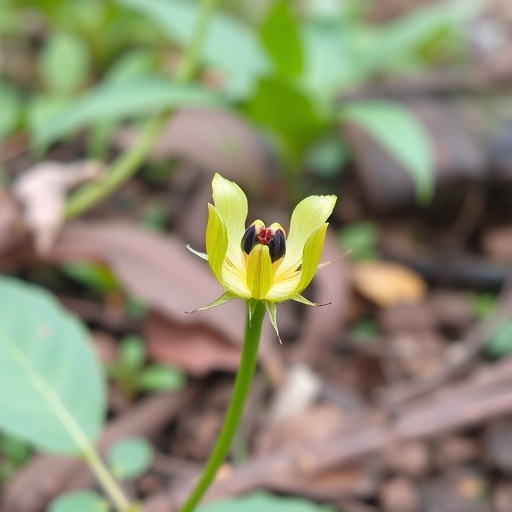PROTECT YOUR DNA WITH QUANTUM TECHNOLOGY
Orgo-Life the new way to the future Advertising by Adpathway
In recent years, the impact of climate change on agricultural productivity has emerged as a pressing concern, particularly for staple crops like rice. Among the various adaptations needed to confront these challenges, heat tolerance has become an essential trait in rice breeding programs. Researchers from various scientific disciplines are converging on this issue, as emerging data continues to unveil the genetic and biochemical underpinnings of heat tolerance in rice plants. A recent article published in BMC Genomics presents significant insights into the interplay between transcriptomics and metabolomics in identifying key flavonoid metabolites and genes associated with heat tolerance in rice.
The study focuses specifically on the rice rel1-D mutant, a variant that exhibits a marked increase in heat tolerance compared to its wild-type counterparts. This mutant has become an important model for researchers aiming to uncover the genetic determinants of resilience in crops. As wheat and maize have their adaptations and protective features against increasing temperatures, research on Oryza sativa—the scientific name for rice—has taken on added urgency due to the cereal’s importance in global food security.
The approach taken by Wu et al. is multifaceted. It integrates both transcriptomic and metabolomic methodologies to paint a comprehensive picture of how certain flavonoid metabolites confer heat tolerance. Transcriptomics allows researchers to assess gene expression profiles in response to temperature variations, while metabolomics focuses on the small molecules—metabolites—that are produced as a result of these gene expressions. This holistic analysis reveals a complex network of interactions among genes, enzymes, and the resultant compounds that contribute to thermal resilience.
Flavonoids, a diverse group of phytonutrients found in many plants, play critical roles in mediating plant responses to environmental stresses. They are known for their antioxidant properties and ability to buffer against the harmful effects of reactive oxygen species generated during heat stress. By identifying which flavonoid metabolites are associated with the enhanced heat tolerance in the rel1-D mutant, Wu et al. provide a clearer view of the metabolites that could be targeted in future breeding programs.
The significance of identifying these metabolites cannot be understated, as they provide potential biomarkers for selecting heat-tolerant varieties. Moreover, understanding the genes responsible for producing these metabolites gives researchers a blueprint for genetic modifications or selective breeding practices. By leveraging this knowledge, breeders can accelerate the development of rice varieties capable of thriving under elevated temperatures, thus safeguarding food supplies against climate unpredictability.
Additionally, the integration of omics approaches in this study highlights the growing trend of employing multi-layered data analysis to solve complex biological phenomena. Traditionally, studies focused on either the genetic or metabolic aspect, often overlooking the interconnected nature of these processes. Wu et al.’s application of an integrated approach not only enhances our understanding of the biology behind heat tolerance but also sets a precedent for future studies aiming at the intersection of genetics and biochemistry in agricultural research.
The researchers conducted extensive experimental analyses, examining the transcriptomic profiles of gene expression in both the rel1-D mutant and wild-type rice plants subjected to controlled heat stress. Following the transcriptomic analysis, a detailed metabolomic assessment was conducted to identify the key flavonoids produced during the heat exposure, further elucidating the pathways affected by the stress. Such thorough research designs underscore the rigorous methodology adopted by the authors, ensuring that their findings are rooted in robust experimental science.
Moreover, the study reveals that several specific genes related to flavonoid biosynthesis were upregulated in the heat-tolerant mutants. These genes are crucial for the production of flavonoid compounds that potentially mitigate heat stress, highlighting not only their biological significance but their potential as targets for genetic engineering. The elucidation of these pathways is vital, providing insights into how rice plants can be tailored to adapt more readily to heat stress conditions.
Notably, this research contributes to an expansive body of literature aiming at improving crop resilience through genetic means. The safety and sustainability of our agricultural systems are of utmost importance, especially as the global population continues to rise. Thus, the urgency for developing climate-resilient crops cannot be overlooked.
Another compelling aspect of this research is the discussion around the potential practical applications of the findings. By expanding our understanding of the role of specific metabolites like flavonoids in heat tolerance, we can envision a future where rice varieties are engineered or selected for their ability to withstand not just heat, but other stressors such as drought or salinity. The implications extend beyond rice, as the methodologies and findings may also inform breeding practices for other important crops facing similar climate challenges.
The insights gained from the integrated transcriptomic and metabolomic analysis serve as an excellent illustration of how modern research can address age-old agricultural problems. Ultimately, the integration of multiple disciplines in studying complex biological systems will be crucial as we strive to improve food security amid the changing climate. As the findings from Wu et al. gain traction, they illuminate a pathway forward in the quest for sustainable agricultural practices.
In summary, Wu et al.’s study on the heat tolerance of the rice rel1-D mutant marks a pivotal moment in plant science, showcasing how a concerted focus on both gene expression and metabolic pathways can yield significant insights into resilience mechanisms. The collaboration of multidisciplinary approaches promises not only to advance our understanding of plant biology but to equip agricultural practitioners with the tools needed to combat the challenges posed by global climate change.
As researchers continue to explore the depths of plant genetics and biochemistry, we remain hopeful that innovative solutions emerge, transforming the landscape of agriculture and ensuring that quality food sources remain accessible for generations to come.
Subject of Research: Heat Tolerance in Rice
Article Title: Integrated Transcriptomic and Metabolomic Analysis Unveils Heat-Tolerance-Associated Flavonoid Metabolites and Genes in the Rice rel1-D Mutant
Article References:
Wu, X., Yang, L., Han, J. et al. Integrated transcriptomic and metabolomic analysis unveils heat-tolerance-associated flavonoid metabolites and genes in the rice rel1-D mutant. BMC Genomics 26, 792 (2025). https://doi.org/10.1186/s12864-025-11977-0
Image Credits: AI Generated
DOI: 10.1186/s12864-025-11977-0
Keywords: Heat Tolerance, Rice, Transcriptomics, Metabolomics, Flavonoids, Climate Change, Crop Resilience, Genetic Engineering.
Tags: agricultural productivity challengesbiochemical pathways in rice plantsbreeding programs for resilient cropsclimate change impact on cropsflavonoid metabolites in agriculturefood security and climate adaptationgenetic determinants of heat resistanceheat tolerance in ricemultidisciplinary approaches in crop researchOryza sativa research advancementsrice mutant rel1-Dtranscriptomics and metabolomics in rice


 3 hours ago
13
3 hours ago
13





















 English (US) ·
English (US) ·  French (CA) ·
French (CA) ·